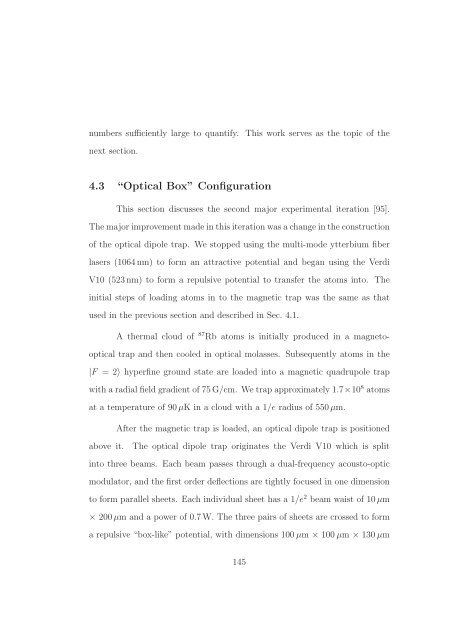Single-Photon Atomic Cooling - Raizen Lab - The University of ...
Single-Photon Atomic Cooling - Raizen Lab - The University of ...
Single-Photon Atomic Cooling - Raizen Lab - The University of ...
You also want an ePaper? Increase the reach of your titles
YUMPU automatically turns print PDFs into web optimized ePapers that Google loves.
numbers sufficiently large to quantify. This work serves as the topic <strong>of</strong> the<br />
next section.<br />
4.3 “Optical Box” Configuration<br />
This section discusses the second major experimental iteration [95].<br />
<strong>The</strong> major improvement made in this iteration was a change in the construction<br />
<strong>of</strong> the optical dipole trap. We stopped using the multi-mode ytterbium fiber<br />
lasers (1064 nm) to form an attractive potential and began using the Verdi<br />
V10 (523 nm) to form a repulsive potential to transfer the atoms into. <strong>The</strong><br />
initial steps <strong>of</strong> loading atoms in to the magnetic trap was the same as that<br />
used in the previous section and described in Sec. 4.1.<br />
A thermal cloud <strong>of</strong> 87 Rb atoms is initially produced in a magneto-<br />
optical trap and then cooled in optical molasses. Subsequently atoms in the<br />
|F = 2〉 hyperfine ground state are loaded into a magnetic quadrupole trap<br />
with a radial field gradient <strong>of</strong> 75 G/cm. We trap approximately 1.7×10 8 atoms<br />
at a temperature <strong>of</strong> 90µK in a cloud with a 1/e radius <strong>of</strong> 550µm.<br />
After the magnetic trap is loaded, an optical dipole trap is positioned<br />
above it. <strong>The</strong> optical dipole trap originates the Verdi V10 which is split<br />
into three beams. Each beam passes through a dual-frequency acousto-optic<br />
modulator, and the first order deflections are tightly focused in one dimension<br />
to form parallel sheets. Each individual sheet has a 1/e 2 beam waist <strong>of</strong> 10µm<br />
× 200µm and a power <strong>of</strong> 0.7 W. <strong>The</strong> three pairs <strong>of</strong> sheets are crossed to form<br />
a repulsive “box-like” potential, with dimensions 100 µm × 100 µm × 130 µm<br />
145
















